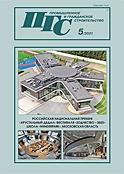BACK
- BUILDING MATERIALS AND PRODUCTS
- Chemical Destruction Of Mineral Wool
- UDC 691-494:691.619.8 DOI: 10.33622/0869-7019.2021.05.26-33
Dmitry Yu. ZHELDAKOV, e-mail: djeld@mail.ru
Research Institute of Building Physics of the Russian Academy of Architecture and Construction Sciences, Lokomotivnyy proezd, 21, Moscow 127238, Russian Federation
Abstract. The international standard used for the determination of residual ions in the production of mineral wool is analyzed. It is noted that this document has some inaccuracies in the terminology, the quality and quantity of the defined elements, the methods of research and the interpretation of the results obtained. A scientific hypothesis, that during the operation of mineral wool in the enclosing structure and its moistening, chemical reactions can occur between the components of the material, leading to its destruction, is formulated. The analysis of chemical reactions is carried out on the basis of the thermodynamic method of studying reactions, which is an estimate for understanding the probability of the process as a whole and makes it possible to determine the preference of reactions, as well as the stability of the resulting compounds in solutions, their energy potential and the direction of the processes. The Gibbs-Helmholtz equation makes it possible to estimate the flow of a chemical process by the isobaric-isothermal potential. On the basis on the analysis performed, it is concluded that it is possible to develop a method for calculating the durability of the mineral wool operation in the enclosing structure.
Key words: mineral wool, enclosing structures, durability, chemical corrosion, residual ions. - REFERENCES
1. Gagarin V. G., Pastushkov P. P. Sorption of water vapor by materials of mineral wool products of modern production. Stroitel'nye materialy, 2019, no. 6, pp. 40-43. (In Russian).
2. Gagarin V. G., Pastushkov P. P Sorption of water vapor by materials of mineral wool products of modern production. Part II. Stroitel'nye materialy, 2020, no. 6, pp. 33-38. (In Russian).
3. Pastushkov P. P. On the sorption of water vapor by modern mineral wool products. Energosberezhenie, 2020, no. 4, pp. 36-37. (In Russian).
4. Melkonyan R. G. Technology of obtaining potassium and sodium liquid glasses by hydrothermal-alkaline processing of amorphous rocks. Tekhnika i tekhnologiya silikatov, 2012, vol. 19, no. 4, pp. 20-26. (In Russian).
5. Lotov V. A., Khabibulin Sh. A. Application of modified liquid-glass binder in the production of building materials. Stroitel'nye materialy, 2015, no. 1, pp. 73-77. (In Russian).
6. Hong S., Yoon M., Hwang H. Fabrication of spherical silica aerogel granules from water glass by ambient pressure drying. Journal of the American Ceramic Society, 2011, vol. 94, iss.10, pp. 3198-3201.
7. Zheldakov D. Yu. The brick material durability in brickwork. AlfaBuild, 2020, vol. 15, article 1504. DOI: 10.34910/ALF.15.4.
8. Zheldakov D. Yu. Methods of investigation of the kinetics of the chemical corrosion process of brick masonry materials. Izvestiya vuzov. Stroitel'stvo, 2019, no. 11(731), pp. 74-86. (In Russian).
9. Lotov V. A. Phase diagram of the processes of hydration and hardening of cement. Tekhnika i tekhnologiya silikatov, 2014, vol. 21, no. 2, pp. 23-26. (In Russian).
10. Teylor Kh. F. U. Himija cementov [Chemistry of cements]. Moscow, Stroyizdat Publ., 1969. 502 p. (In Russian).
11. Burciaga-Dнaz O., Escalante-Garcнa J. Structure, mechanisms of reaction, and strength of an alkali-activated blast-furnace slag. Journal of the American Ceramic Society, 2013, vol. 96, iss. 12, pp. 3939-3948.
12. Korolev E. V., Grishina A. N. Filled binder for the water-glass based radiation-protective composites. Advanced Materials Research, 2013, vol. 746, pp. 281-284.
13. Zheldakov D. Yu. Brickwork chemikal corrosion features. International science and technology conference "EarthScience". IOP Conf. Series: Earth and Environmental Science, 2020, no. 459, pp. 062089. DOI: 10.1088/1755-1315/459/6/062089.
14. Stachowicz A., Granat K., Nowak D., Haimann K. Effect of hardening methods of moulding sands with water glass on structure of bonding bridges. Archives of Foundry Engineering, 2010, vol. 10, iss. 3, pp. 123-128. - For citation: Zheldakov D. Yu. Chemical Destruction of Mineral Wool. Promyshlennoe i grazhdanskoe stroitel'stvo [Industrial and Civil Engineering], 2021, no. 5, pp. 26-33. (In Russian). DOI: 10.33622/0869-7019.2021.05.26-33.
BACK


